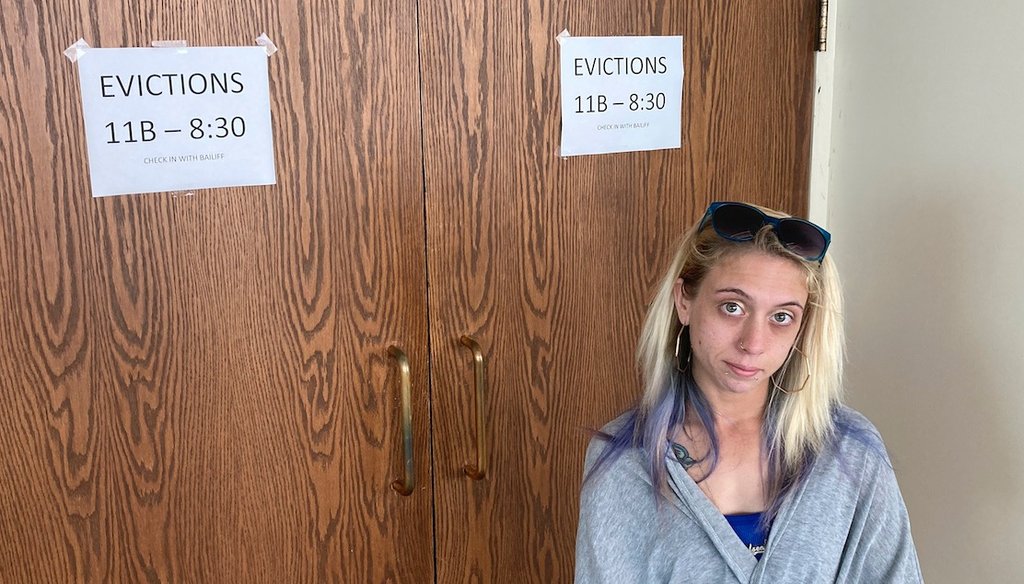Stand up for the facts!
Our only agenda is to publish the truth so you can be an informed participant in democracy.
We need your help.
I would like to contribute

Chelsea Rivera, 27, stands outside Franklin County evictions court in Columbus, Ohio. The single mom is behind $2,988 in rent and late fees for the one bed-room apartment she rented for herself and her three young sons. (AP Photo/Andrew Welsh-Huggins)
If Your Time is short
-
A CDC-ordered eviction moratorium expired July 31, and top Democrats are at odds about how to revive it.
-
About 3.6 million people face eviction within two months, and about 6 million households are behind on their rent; estimates of the back rent owed are in the tens of billions of dollars.
-
About $42 billion in aid remains unspent, as many states struggled to set up rental assistance programs.
EDITOR’S NOTE, Aug. 4, 2021: On Aug. 3, the CDC announced it was issuing a "new order temporarily halting evictions in counties with heightened levels" of coronavirus transmission. This follow-up article addresses the scope of the new CDC approach as well as the legal challenges.
The eviction moratorium that gave millions of households a cushion as the pandemic upended their lives expired July 31. Now top Democrats are at odds over how to get it started again.
President Joe Biden said neither the White House nor the CDC has the authority to renew the program. He called on Congress to approve an extension. But House Speaker Nancy Pelosi and her top Democratic lieutenants, doubtful they can get the divided Senate to go along, want the White House to take unilateral action.
Meanwhile, more than $42 billion in federal emergency rental assistance remains untouched.
How did the rental assistance programs work, and what happens now? Here’s what we know so far:
Sign up for PolitiFact texts
Moratorium paired with emergency rental assistance
The eviction moratorium was first imposed in September 2020 as a public health measure by the Centers for Disease Control and Prevention to prevent homelessness and contain the spread of COVID-19. The CDC extended it three times.
The moratorium didn’t erase the rent that was due. It simply said people couldn’t be evicted if they fell behind. To provide financial relief to both renters and landlords, Congress provided about $46.5 billion for the Emergency Rental Assistance program in two installments. The first $25 billion was passed in December, and the American Rescue Plan Act enacted in March provided another $21.55 billion. The Treasury Department oversees the program and reported in early July that a total of $33.6 billion had been released to the states.
The most recent spending report shows about $3 billion in aid has been spent so far on rent and utilities, meaning that about $42 billion is still available.
How many people face eviction, and how much do they owe?
There’s a wide range of estimates of how many people are at risk. Some analyses say 3.6 million people; others put the number at 6.4 million households.
The lower number comes from a question in the Census Bureau’s Household Pulse Survey that asks how many people face eviction within the next two months.
The higher figure comes from the same survey, but looks at a different question: how many people are behind on their rent.
The Urban Institute relied on the eviction number, which indicates how many face an immediate crisis. The National Equity Atlas, a project of the University of Southern California’s Equity Research Institute and PolicyLink, used the larger figure on late rent, an indicator how many people might be at risk as time goes by. Both shed some light on the scale of the problem.
Estimates put the total of back rent in the tens of billions.
The National Equity Atlas estimates the rent outstanding at $21.3 billion. A January study for the National Council of State Housing Agencies put the amount of back rent owed at between $13.2 billion and $24.4 billion. Another analysis at about the same time, published by the Urban Institute, said the amount could reach $52.6 billion.
Why hasn’t most of the federal rental assistance money been spent?
For starters, the scale of the program is unprecedented, said Shamus Roller, executive director of the National Housing Law Project.
"There are major logistical challenges to setting up these programs," Roller said. "Some states and cities have effective programs, and some have programs that are failing."
Once Congress greenlighted the money in late December, the Treasury Department had to write the rules for how to spend it. Those came in February. Then, "states and localities had to interpret the Treasury’s guidance and create new programs, which takes time," housing analysts at the Urban Institute wrote July 14.
Washington loosened the rules to help speed things up. It told housing agencies that if landlords didn’t want to participate, they could give the money directly to the tenants. It said landlords could submit aid applications for many units at the same time.
The Treasury Department singled out Virginia and Texas for moving quickly to stand up programs and get aid out the door. Virginia provided more than $155 million. By early July, Texas had delivered more than $450 million in assistance to about 70,000 households.
The pace at the state and local level has accelerated. Housing agencies spent $1.5 billion in June, about half of all the money spent to date.
Can the moratorium be extended?
The CDC extended the moratorium three times, but landlords and the real estate industry in several states filed suit to challenge the action as an overreach of federal power. A June Supreme Court ruling in one of those suits allowed the moratorium to remain in place until it expired at the end of July, but it didn’t fully resolve the question of whether the CDC had the proper authority to impose it in the first place — or whether it can again.
Justice Brett Kavanaugh joined the 5-4 majority — along with the court’s three liberals and Chief Justice John Roberts — to let the moratorium continue, but indicated that he did so only because it was about to end. As a matter of law, he said, he thought such a step required congressional authorization.
The Biden administration appears to have arrived at the same position. Before the moratorium expired, Biden said the CDC lacks the authority, and Congress would need to pass a law codifying the moratorium on evictions.
On Aug. 1, House Speaker Nancy Pelosi and other top House Democrats said the House could pass an extension, but "it is clear that the Senate is not able to do so." So she put the ball back in Biden’s court.
"Action is needed, and it must come from the administration," Pelosi’s joint statement said.
The White House reiterated its position that it can’t.
Press secretary Jen Psaki said in an Aug. 2 statement, "CDC Director Rochelle Walensky and her team have been unable to find legal authority for a new, targeted eviction moratorium."
But Psaki said administration lawyers are looking for a new legal justification. And meanwhile, the White House is calling on states and landlords to do what they can to forestall evictions.
Our Sources
Treasury Department, Emergency Rental Assistance Program, accessed Aug. 2, 2021
Treasury Department, Key Findings from Program Interim Report, July 2, 2021
Treasury Department, Amount of June Emergency Rental Assistance Resources to Households More Than All Previous Months Combined, July 21, 2021
Congressional Research Service, The CDC’s Federal Eviction Moratorium, June 30, 2021
Urban Institute, Many People are Behind on Rent. How Much Do They Owe?, Feb. 24, 2021
University of Southern California, National Equity Atlas, Rent debt in America, accessed Aug. 2, 2021
Urban Institute, Three Ways States and Localities Can Get Rental Assistance to People Faster, July 14, 2021
Urban Institute, Averting an Eviction Crisis, Jan. 25, 2021
National Council of State Housing Agencies, Analysis of Current and Expected Rental Shortfall and Potential Evictions in the U.S., Sept. 25, 2020
U.S. Census Bureau, Week 33 Household Pulse Survey: June 23 – July 5, July 14, 2021
White House, Statement by Press Secretary Jen Psaki on Eviction Prevention Efforts, Aug. 2, 2021
House Speaker’s Office, Joint Leadership Statement Calling on Biden Administration to Extend Eviction Moratorium, Aug. 1, 2021
Tampa Bay Times, Florida has disbursed 2 percent of rent aid as eviction moratorium ending, July 30, 2021
Email exchange, Shamus Roller, executive director, National Housing Law Center, Aug. 2, 2021





















































